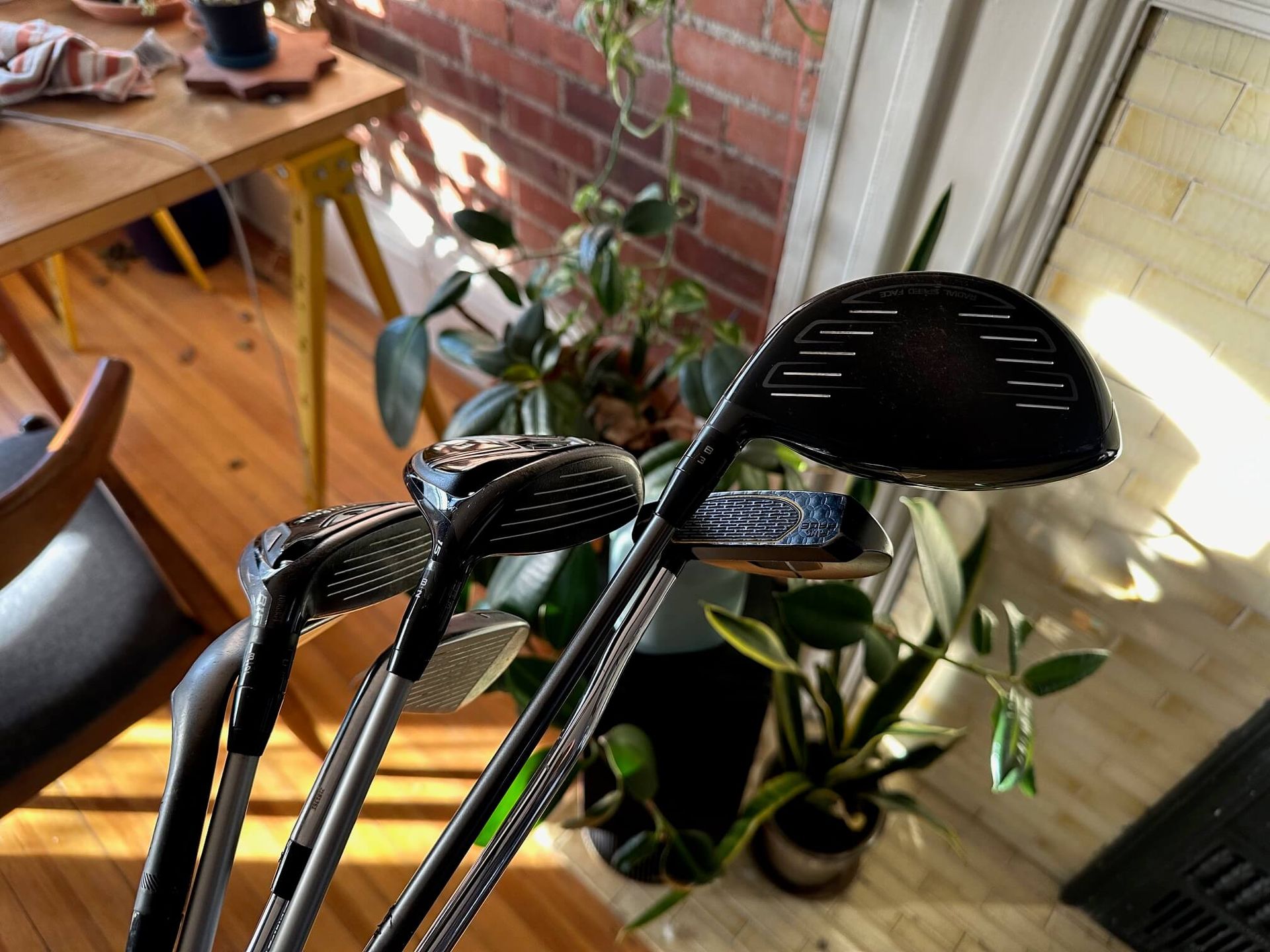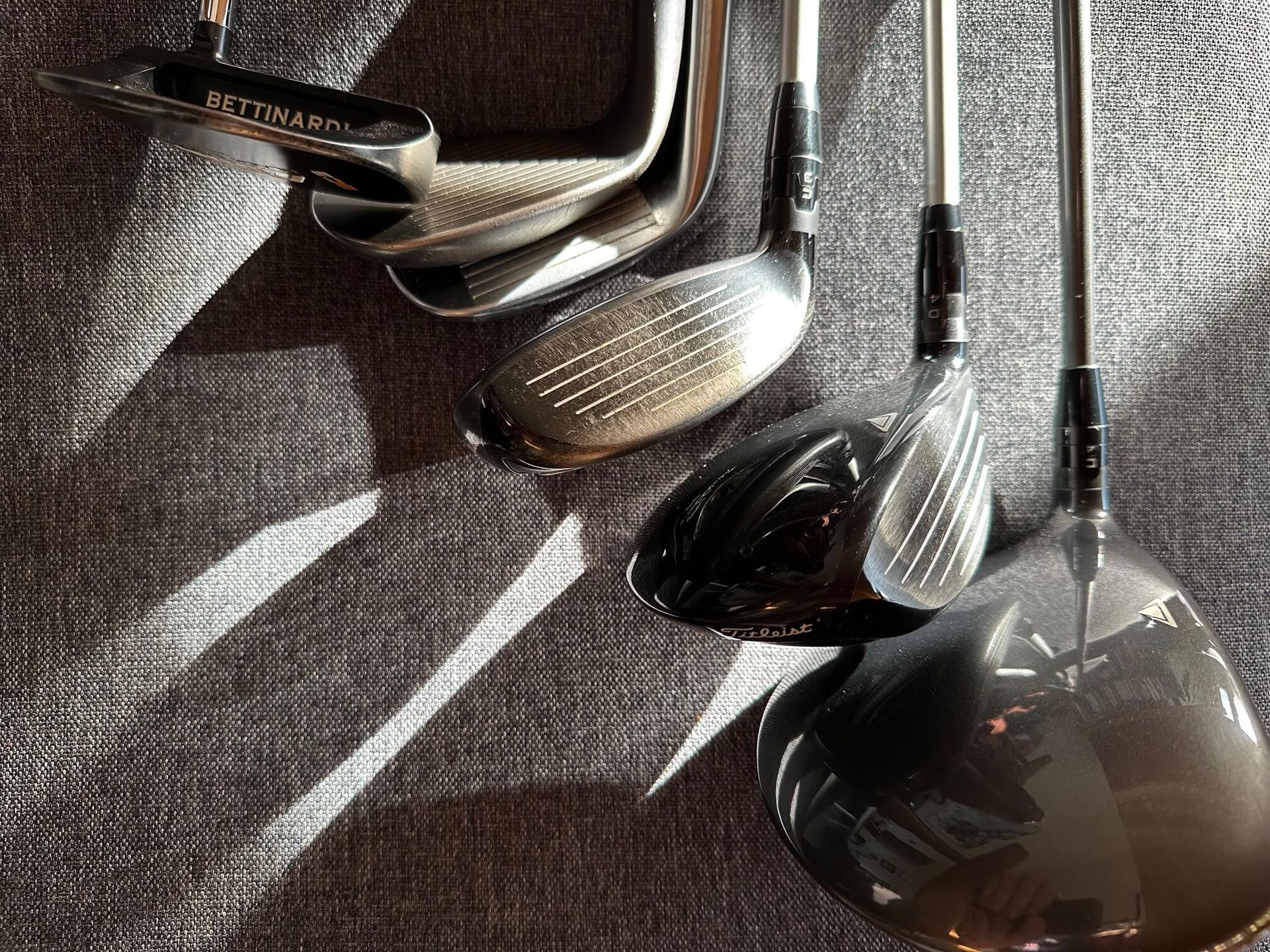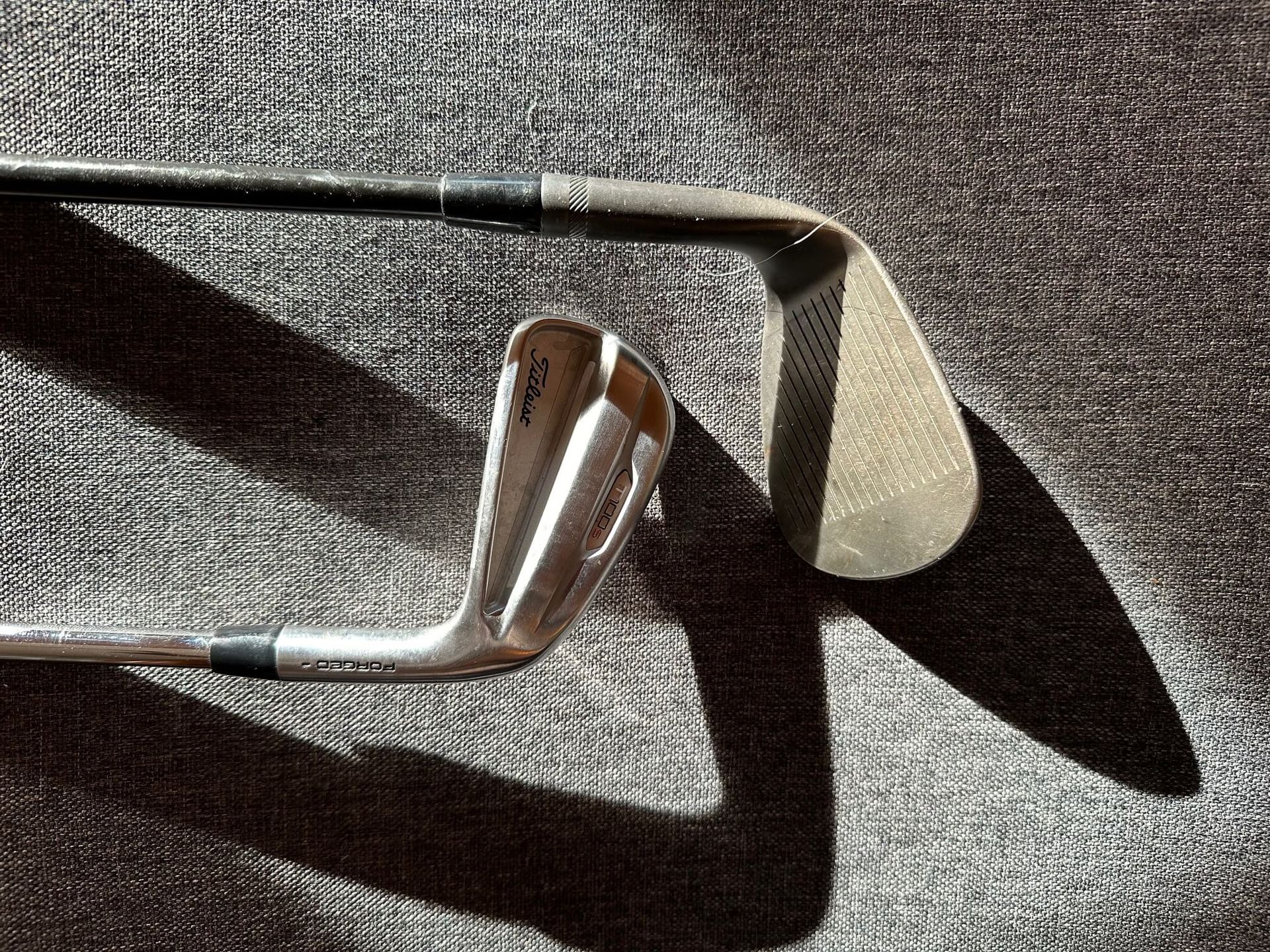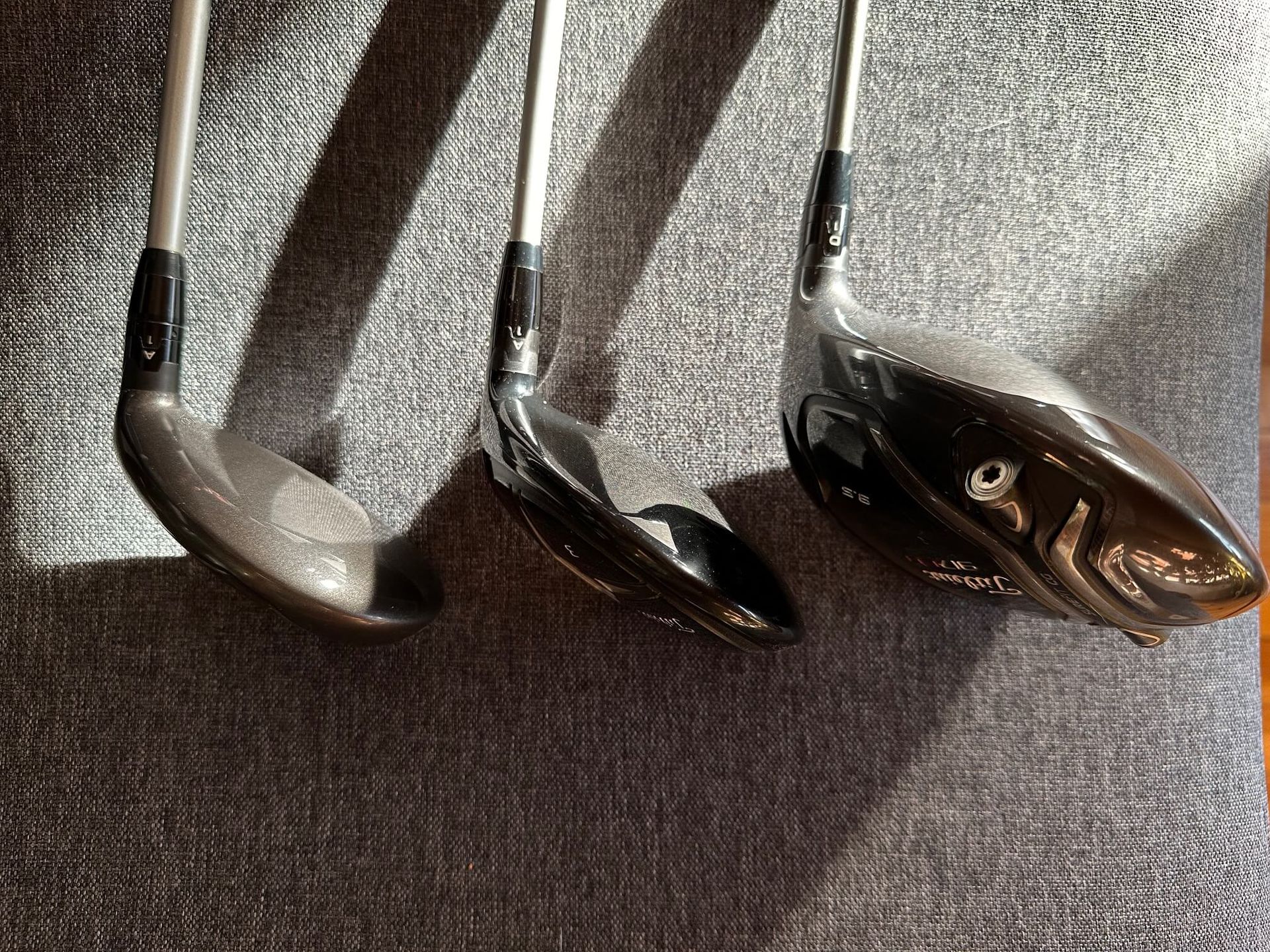Explaining Every Type of Golf Club
Written by: Tony Schwartz
Last Updated: January 16, 2025
Understanding the different types of golf clubs is one of the many joys of learning the game of golf. Golf clubs are central to enjoying and understanding the game whether you're a beginner or an experienced player. Developing your knowledge of the golf clubs in your bag allows you to play the game on a much more informed basis and facilitates better play that can lead to improved scores. After all, we're all here because we'd like to be better at the game of golf and understanding each club in your bag is critical for getting there.
The process of learning different types of golf clubs, use cases, and terms that accompany each can enhance your overall understanding and enjoyment with the game of golf as well as offer you the opportunity to make better, more confident decisions on the golf course. The more we know and learn about the golf clubs we're using, the more potential we have to make better choices on the golf course that lead to lower scores, better shot outcomes, and an overall better experience.
The following guide is meant to offer a comprehensive overview of every type of golf club, how each is used, factors which may affect your club choice in various scenarios, reference images, and even lofts for each club type. We hope the following guide is helpful for you no matter where you are on your journey with golf.
Benefits of Learning the Types of Golf Clubs
Taking the time to learn various golf clubs, their use cases, and their relevance to playing golf will unlock meaningful benefits on the journey of being a golfer. We think there are a number of different benefits to learning the different types of golf clubs, and to name a few of the key benefits:
- Understanding Specific Clubs for Specific Situations: Each type of golf club is designed for a specific kind of shot or situation on the golf course. For example, drivers are used for long-distance tee shots, irons for a variety of shots depending on their number (lower-numbered irons for longer shots, higher for shorter ones), and putters are used on the green for rolling the ball into the hole. Knowing which club to use in each situation is essential for playing effectively.
- Improving Accuracy: Different clubs have different lofts, lengths, and head designs, which affect the distance and trajectory of the ball. Using the right club can help a golfer achieve greater accuracy and control over their shots, which is key to scoring well.
- Skill Development: As golfers progress, they learn to make subtle adjustments in their swing for different clubs. This skill development is part of becoming a better golfer. Knowing how to use various clubs effectively contributes to a more rounded skill set.
- Course Management: Good golfers need to understand how to navigate a golf course strategically. This includes knowing which club to use to avoid hazards, reach the green effectively, or get out of tricky situations like sand bunkers or roughs.
- Confidence and Mental Game: Being familiar with all the clubs in their bag gives golfers confidence on the course. A significant part of golf is mental, and knowing you have the right tool for each shot can boost a player's confidence.
- Adapting to Different Conditions: Weather and course conditions can significantly affect play. For instance, on a windy day, a golfer might choose a club that keeps the ball lower to the ground. Knowing all the clubs and their characteristics allows a golfer to adapt to these varying conditions.
In summary, understanding the different types of golf clubs is fundamental to playing golf well. It affects a player's ability to make the right decisions, execute various shots, and develop their skills over time.

Choosing the Right Golf Club: Drivers, Woods, Hybrids, Irons, Wedges, and Putters
Choosing the right golf clubs can be a varied experience depending on what you're looking for. My first set of golf clubs came from a local garage sale my grandfather found when scouring the local neighborhoods of East Moline and Moline (Illinois). My initial set of golf clubs included woods, irons, a pitching wedge, and a putter. For some, a full set might include irons or maybe even only one club to start. All of it works for improving your game.
In golf, there are different types of clubs that are most commonly found in golfers' bags: drivers, woods, hybrids, irons, wedges, and putters. The USGA mandates the maximum number of clubs to 14 for any golfer, though you are allowed to have fewer than 14 clubs at any time. There are also no requirements for the types of clubs you carry in your bag. In other words, you can carry any combination of drivers, woods, wedges, hybrids, irons, and putters you'd like that add up to a maximum total of 14 clubs. AS George Costanza says, "We're living in a society!" and this concept is also true in the world of golf where most golfers are carrying a similar combination of golf clubs to accommodate the more common types of golf shots during a round.
Below is a breakdown of the types of golf clubs, the calibration of choices for using each type of golf club, and examples of scenarios where each club may be used:
Drivers
- Use Case: Primarily used for long-distance tee shots on par-4 and par-5 holes.
- Characteristics: Drivers have the longest shafts and largest heads of all golf clubs, providing the most distance. They have the lowest loft, usually between 9 and 13 degrees, which helps in achieving long-distance shots.
- Example: On a 450-yard par-4 hole, a golfer would typically use a driver off the tee to cover as much distance as possible in the first shot.
Woods
- Use Case: Used for long-distance shots when a driver is not appropriate or for second shots on par-5s.
- Characteristics: Woods, including the 3-wood and 5-wood, have shorter shafts than drivers but are still designed for long-distance shots. They have higher lofts than drivers, providing more control.
- Example: On a long par-5, after the tee shot with a driver, a golfer might use a 3-wood for the second shot to continue covering a significant distance.
Irons
- Use Case: Irons are used for a variety of shots, from long to short distances, depending on the number. Lower-numbered irons (2-iron to 5-iron) are for longer shots, mid-irons (6-iron to 8-iron) are for intermediate distances, and higher-numbered irons (9-iron and pitching wedge) are for shorter, more precise shots.
- Characteristics: Irons have varying lofts, with lower-numbered irons having less loft and therefore used for longer shots. The loft increases as the iron number increases.
- Example: For a 150-yard approach to the green, a golfer might choose a 6-iron or 7-iron, depending on their strength and the wind conditions.
Wedges
- Use Case: Wedges are used for short-distance shots, typically within 120 yards of the green, and for shots requiring high precision, like getting out of sand bunkers.
- Characteristics: These include the pitching wedge, sand wedge, lob wedge, and gap wedge. They have the highest lofts, which allow for more precise control and higher ball flight.
- Example: To get the ball out of a sand bunker near the green, a golfer would use a sand wedge.
Putters
- Use Case: Used exclusively on the green to roll the ball into the hole.
- Characteristics: Putters have a flat face, which helps in accurately rolling the ball. They come in various shapes and sizes, tailored to a golfer's style.
- Example: Once on the green, regardless of the distance to the hole, a putter is used to finish the hole.
Hybrid Clubs
- Use Case: Hybrids are a cross between woods and irons and are used as a more forgiving alternative to long irons.
- Characteristics: Hybrids combine the straight-hitting ability of irons with the easy-to-hit characteristics of woods. They are often used for long shots from difficult lies.
- Example: If a golfer struggles with a 3-iron, they might use a 3-hybrid for a 180-yard shot from the rough.
Factors Affecting Club Choice
- Distance to the Hole: The primary factor in club selection. The farther the distance, the lower the number of the club.
- Wind and Weather Conditions: Strong winds might require a club with a lower trajectory.
- Lie of the Ball: Rough, sand, or uneven ground can affect the choice of club.
- Golfer's Skill and Strength: Personal preference and physical ability also play a role in club selection.
In conclusion, choosing the right golf club for a particular situation depends on a combination of the shot's requirements, the golfer's abilities, and the course conditions. This decision-making process is a critical part of the strategy and skill in golf.

A Deep Dive into Drivers, Hybrids, Irons, Wedges, and Putters
Golf, an ancient game with roots spanning back centuries, has evolved extensively over time, and so has the equipment used to play it. My grandfather started playing golf post World War 2 and he was using persimmon woods, and by the time I started playing, those clubs were nowhere to be found (other than places like the USGA Golf Museum). Golf clubs have witnessed major changes in design, materials, and technology.
If you've ever found yourself exploring the plethora of club options available, this guide will break down the different types of golf clubs and their characteristics so that you can more easily navigate the research and buying processes. Our hope at Planet Divot is that, if anything, this guides further invigorates your love of the game and deepens your appreciation for golf and thje equipment that carries us from tee to the bottom of the cup.
Drivers
Drivers are the largest club in the bag, and according to the USGA rulebook drivers cannot exceed 460 cubic centimeters (or 460 cc). Drivers are used primarily for long-distance shots from the tee box on par-4 and par-5 holes. The most common use of the driver from the tee involves using a tee to elevate the golf ball before taking your first shot. Although in some cases for highly skilled players, drivers can be used without a tee in the fairway or with a favorable lie, which is often referred to as using the driver 'off the deck'.
Over the years, driver lofts have evolved. Traditional drivers used to have lofts ranging from 7 to 10 degrees. However, as technology and swing techniques advanced, the typical driver loft increased. Today's drivers offer lofts between 8 to 15 degrees, allowing for a broader range of players to find their optimal launch conditions. Today, golfers can use a golf wrench to adjust the loft and lie of drivers for optimal performance. This tool can help golfers of any skill level and help produce desirable outcomes. Although a golf wrench cannot correct outcomes resulting from improper fundamentals in the golf swing. The best thing to do in that instance is to review golf swing tips.
Hybrids
A relatively newer addition to the golfer's bag, hybrids combine the best elements of woods and irons. They are versatile and can be used for a range of shots, from long approaches to getting out of tricky lies. At address, you will notice the difference between a hybrid and wood because the hybrid has a more shallow head, generally offers higher loft, and the length of the club will generally be less than a wood. I love incorporating hybrids into my game because of their versatility on the tee, in the fairway, in the rough, and even in more difficult lies. I have personally found that hybrids are easier to strike, more forgiving in off-center hits, and have been a viable replacement for longer irons. Although, I have played with other golfers who swear by their fairway woods and long irons and would not put hybrids in their golf bag. It all comes down to personal preference.
Irons
Irons form the backbone of any golfer’s arsenal. They are used for a multitude of shots, from teeing off on short holes to approaching the green. Generally speaking, irons cover the largest range of yardages among all golf club types in your golf bag. With practice and time, you will start to really understand the length that each of your irons produces. I would encourage Planet Divot readers to determine your yardages by visiting the driving range and taking notes. Over time, your irons' yardages will fluctuate, and if you're just starting out, you will likely see gains in yardages that each of your irons produce.

Golf irons are primarily constructed from stainless steel and carbon steel due to their durability and feel. Professionals often used forged irons made of soft carbon steel, offering precision and feedback. Beginners and high-handicappers benefit from cavity-back irons typically made from stainless steel, sometimes combined with tungsten weighting for improved forgiveness. Additionally, cutting-edge irons integrate multi-material constructions, using materials like tungsten, thermoplastic urethane, and even carbon fiber for weight distribution, vibration dampening, and playability across skill levels. These advancements ensure optimal performance tailored to a golfer's specific needs
Here's a bulleted list of the most common lofts for golf irons, from 2-iron through 9-iron:
- 2-iron: 18-20 degrees
- 3-iron: 21-24 degrees
- 4-iron: 25-28 degrees
- 5-iron: 28-32 degrees
- 6-iron: 32-36 degrees
- 7-iron: 36-40 degrees
- 8-iron: 40-44 degrees
- 9-iron: 44-48 degrees
The evolution of iron lofts is a testament to the ongoing quest for optimizing performance. Over the years, manufacturers have decreased the loft in clubs, often referred to as "loft jacking." This allows players to achieve greater distance with the same club number. Enhanced ball technology, improved shaft materials, and swing analytics have allowed players to maintain high ball flights even with decreased lofts. However, it's essential to remember that while club numbers remain consistent, the actual loft may vary significantly between brands and eras. It’s always a good idea to focus on the loft rather than the club number when choosing the right club for a particular shot.
Wedges
Wedges are specialized irons designed for a wide variety of shots on the golf course, especially near the green and from about 100 yards and in. They offer precision and control, making them essential for any golfer.
There are different types of wedges, each with its distinct loft:
- Pitching Wedge (PW): 45-50 degrees
- Gap Wedge (GW) or Approach Wedge (AW): 50-55 degrees
- Sand Wedge (SW): 54-58 degrees
- Lob Wedge (LW): 58-64 degrees
Wedges offer an array of golf shots:
- Pitching: A high, short-distance shot aiming to land the ball softly onto the green.
- Chipping: A low shot around the green, where the ball spends more time rolling than in the air.
- Lob: A shot with a very high trajectory, used to clear obstacles close-by and stop the ball quickly.
- Bunker Shot: Played from sand traps, the club digs under the ball, using the sand to lift the ball out.
- Flopping: Similar to a lob, but played with an open clubface for an even higher, softer landing shot.
- Full Shot: Using a wedge for longer distances, typically from the fairway or rough.
Putters
The club that often determines victory or defeat, putters are used on the greens to roll the ball into the hole. Contrary to popular belief, putters do have loft – usually between 1 to 5 degrees. This slight loft helps lift the ball out of its indentation and sets it rolling smoothly on the green.
There are a variety of different types of putters:
- Blade Putters: The oldest and most basic design, these are flat, narrow, and slightly weighted. Perfect for players with an arc to their stroke.
- Mallet Putters: Larger than blades, they have a rounded shape and are often weighted at the rear. Their design aids alignment and is favorable for players with a straight-back-and-through stroke.
- Center-Shafted Putters: The shaft connects to the center of the putter head. It provides a unique balance and feel, suiting some players' strokes better than the more common heel-shafted designs.
- Belly Putters: Longer than standard putters, these are anchored to the stomach. Although some tournaments now restrict them, many golfers find them effective for stabilizing the hands and arms during the stroke.
- Broomstick Putters: Extremely long putters anchored against the chest. Like belly putters, they minimize wrist action but face some restrictions in competitive play.
- Peripheral Weighted Putters: These putters distribute weight around the edges of the putter head, maximizing forgiveness on off-center strikes.
The right putter depends on a player's comfort, stroke style, and personal preference. Modern innovations also introduce adjustability features, allowing golfers to modify loft, lie, and even weight to fit their stroke perfectly. It is truly amazing how putters have evolved.

The Leading Brands in Golf Clubs
Specific brands have emerged as leaders in golf clubs, creating some of the best golf clubs the industry has ever seen in recent history. Let's delve into the top brands for each type of golf club: drivers, hybrids, irons, wedges, and putters.
Drivers
TaylorMade: Known for their groundbreaking technology and innovation, TaylorMade has consistently produced drivers that are favorites among both professionals and amateurs. Their Stealth 2 series have been particularly noteworthy, providing a combination of distance and forgiveness.
Callaway: Another titan in the world of drivers, Callaway’s Paradym and Rogue series have garnered much acclaim. These drivers incorporate advanced technology to enhance ball speed and overall distance.
Hybrids
Ping: When it comes to hybrids, Ping’s G series offers exceptional performance, combining the best of irons and woods. Their hybrids are known for their versatility and reliability on the course.
Titleist: With their commitment to excellence, Titleist’s hybrids, especially the TSR series, have gained a reputation for their perfect blend of power and precision.
Irons
Mizuno: Widely recognized for their feel and craftsmanship, Mizuno's 221, 223, and 225 irons are their latest release. These Mizuno irons often utilize grain flow forging, enhancing consistency and feel.
Titleist: Known for performance-orientation with varying degrees of forgiveness, feel, and craftsmanship, Titleist irons are a go-to for many players. Titleist ensures that each iron series undergoes rigorous testing, often involving feedback from professional players, ensuring they meet the brand's stringent standards for performance, feel, and quality. I personally use the Titleist T100S irons and absolutely love them!
Srixon: Srixon irons blend Japanese craftsmanship with advanced technology, offering a balance between classic aesthetics and modern performance. Known for their soft forged feel and innovative groove design, they cater to various skill levels, with models like the ZX series emphasizing both control and forgiveness.
Ping: Ping irons are renowned for their innovative engineering and emphasis on forgiveness. With designs like the
G series, they cater to a range of golfers from novices to pros. Known for consistency and adaptability, Ping integrates cutting-edge technology to optimize playability and distance across their iron lineup.
Wedges
Vokey Design: A subdivision of Titleist, Vokey wedges are favored by many PGA Tour professionals. Renowned for their precision and customizable options, these wedges truly stand out.
Cleveland: Apart from their irons, Cleveland’s RTX series wedges deserve a mention. They offer exceptional spin control and versatility around the greens.
Putters
Scotty Cameron: Another offshoot of Titleist, Scotty Cameron putters are almost legendary. Their craftsmanship, balance, and aesthetic appeal make them one of the most sought-after putters in the industry.
Odyssey: A subsidiary of Callaway, Odyssey putters, especially the Stroke Lab series, are lauded for their innovative design and consistency on the greens.
How to Choose the Best Golf Clubs
One of the most amazing aspects of being a golfer in the 21st century is that we have an exorbitant amount valuable information at our disposal which can help us determine the best golf clubs for our game. If you chose, the details of the construction, raw materials, feel, performance, and every aspect of golf clubs could consume this lifetime and five beyond it.
To some, that existence doesn't seem so bad! But for the vast majority of people, they don't have the time, energy, or ability to sift through all of the information about golf clubs out there...and you don't have to!
Golf club manufacturers have gotten really good at accommodating 99.5% of golfers with technology that's readily and publicly available, such as the technology in my favorite Titleist irons. I'm of the belief that this set of irons can last me the next 10 years comfortably. Sure, I could continuously search for the very best golf clubs at any given time, but the truth is that most golfers don't need the very best technology, and in some cases more forgiving technology is required for golfers with higher GHIN. Personally, I enjoy the opportunity to recommend approachable ways for people to integrate with the game of golf, find their best golf clubs for that point in time, and try to reduce the 'equipment argument' for why golf is unapproachable as a hobby for most (even though diversity and accessibility is improving).
Planet Divot's Approach for Choosing the Best Golf Clubs for You
Let's assume that the process of choosing the best golf clubs for you is dependent on purchasing these items. If that's the case then we'll want to start by determining the budget.
First and foremost "never underestimate your budget". And yes, that includes a budget of zero dollars. Seriously, people and organizations have golf clubs that they're willing to donate or that you might be able to trade for. So if you're interested in getting involved with the game of golf and you do not have any money to spend on the sport, I assure you that you can still play golf and get your own equipment. It is a matter of finding garage sales, estate sales, Craigslist ads, word of mouth, or other means to try and facilitate a gift or trade. In my experience, a lot of people just want the golf clubs out of their house or whichever space they're cleaning, so it's a matter of being at the right place when the opportunity strikes.
After you have a budget in mind, I think it's critical to identify the club types you want to secure.
Don't overthink it! If you're in need of a brand new driver, used set of irons, custom pair of wedges, an old putter...no matter what you need, there is a location that can help you find what you're looking for!
Depending on budget and the type of clubs you want to secure, you will be able to identify your purchasing options.
So if you have $0, are looking for a trade, and need a set of irons then I would suggest looking on Craigslist, Facebook marketplace, roadside signs for garage and estate sales, and ask around in your community! Maybe even try to visit your local municipal course or driving range as they may be willing to let you borrow clubs to practice with for free!
On the flip side, if you are a single-digit GHIN player looking for a brand new custom set of irons from a premium manufacturer then your journey will take you into a technology-supported fitting experience with licensed professionals.
Somewhere in the middle exists a robust community of golfers who buy lightly used or last year's models with a great pleasure and joy! I admit that I have lived most of my golfing career in this place, which allows me to continuously upgrade, feel improvements in equipment swaps, see improvements in my game, and honestly be prouder of the bag I carry to each round! There are several online resources for verified used equipment out there, and over time, we'll continuously try to feature used golf club options for anyone who is interested because inclusivity is a pillar of Planet Divot.
In Conclusion
Understanding the different types of golf clubs, their lofts, lies, types of shots they accommodate, historical context of their evolution, and the leading brands for each club type can help your golf game in more ways than one. Whether you’re a beginner trying to decipher the world of golf clubs or an experienced player aiming to fine-tune your choices, knowing your clubs can be as rewarding as a well-played shot. Good luck out there!
